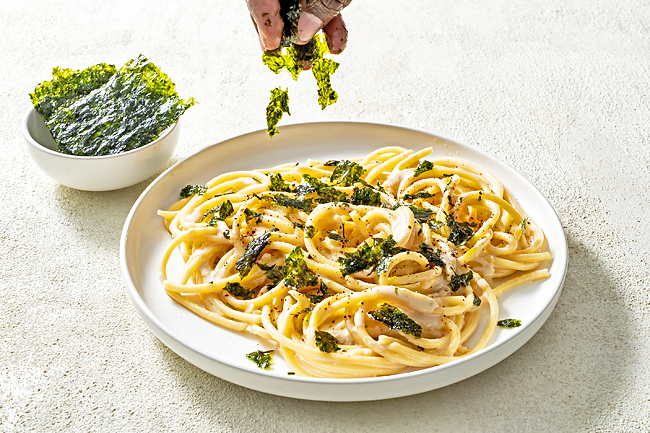Aaron Hutcherson
THE WASHINGTON POST – One of the things I love most about writing every month on the topic of pantry-friendly meals is that it has forced me to think outside of my own notion of the kitchen pantry.
The ingredients I typically have on hand could be vastly different from those found in my neighbour’s kitchen.
Take a look inside New York Times food writer Eric Kim’s kitchen and you’ll likely find seasoned roasted seaweed, also known as gim. In his debut cookbook, Korean American, Kim highlights the versatility of gim in a recipe for creamy bucatini, “a simple, perfect little black dress of a pantry dish”, he wrote.
Though often marketed as a snack, Kim’s mantra is that roasted seaweed is much more than that: “It’s a powerhouse ingredient,” he wrote, calling it “one of the greatest Korean pantry items of all time”.
Over the phone, Kim recounts memories of watching old ladies at the end of the grocery store checkout line hand-roasting paper-size sheets of gim over a metal griddle, brushing them with sesame oil and then sprinkling them with salt. He loves adding it to “anything that has a comforting blandness,” he said, mentioning porridge, rice dishes and oatmeal as examples. “You need a blank canvas to really be able to appreciate the nuances of the umami in the seaweed and also the nuttiness of sesame oil.”
While not all gim is brushed with sesame oil, its nuttiness is one of the ingredient’s defining characteristics for Kim. That flavour, along with salt, are what distinguish gim from Japanese nori, which is often unseasoned. “It’s that flavour of the sesame oil and salt that makes you think of gim,” Kim said. “So there’s a reason I’m fortifying any gim dish with those two extra ingredients, because I think if you’re Korean and you grew up with gim, you kind of associate that flavour, salty and nutty, with roasted seaweed.”
This dish came about while Kim was experimenting during the pandemic. Inspired by fettuccine Alfredo, his recipe in the book calls for heavy cream and fresh garlic to create a simple sauce to slick delightfully chewy bucatini noodles, and the addition of gim “has this umami as if you’ve added shrimp to your Alfredo”, he said. I made this already pantry-friendly recipe even more so by using canned evaporated milk and garlic powder to make the sauce.

Kim urges cooks not to be shy about salt when preparing this dish: “You really need extra salt to pick up the flavours of those quiet ingredients,” he said.
“I call them quiet because they’re not punching you in the face. But if you coax them out well, then it’s just a very comforting flavour to me.”
Kim credits his recipe tester, Rebecca Firkser, who suggested the pinch of gochugaru, a mild Korean red chilli flake with a hint of sweet smokiness.
“It’s kind of nice to have a little bit of that heat,” he said. “It’s a very rich dish.” In my first test of this recipe, I didn’t have any gochugaru on hand and grabbed crushed red pepper flakes, which have a much louder spice profile. Though I enjoyed it, Kim suggests Aleppo pepper as a closer substitute.
Once plated, you crush the gim with your hands and messily sprinkle it over the pasta, said Kim, “I think there’s some beauty in the organised chaos.”
CREAMY BUCATINI WITH ROASTED SEAWEED
15 minutes
Three to four servings
INGREDIENTS
– Fine salt
– Eight ounces dried bucatini
– One can evaporated milk
– One teaspoon garlic powder
– One tablespoon toasted sesame oil
– Freshly ground black pepper, for serving
– Flaky sea salt, for serving
– One package roasted seaweed snacks, preferably sesame flavoured, or more to taste
– Gochugaru, Aleppo pepper or crushed red pepper flakes, for serving (optional)
DIRECTIONS
Bring a large pot of water to a boil and salt it generously.
Add the bucatini and cook until pliable, four to five minutes.
Reserve one cup of the starchy pasta water, then drain the bucatini and return it to the pot.
Add the milk, garlic powder and about half of the reserved pasta water to the pasta (saving the rest of the water to thin out the sauce later if needed).
Bring to a simmer over medium-high heat, stirring constantly until the sauce reduces by half and slicks the bucatini, four to five minutes.
Stir in the sesame oil.
Taste and season with more salt if needed (the pasta should be generously salted to complement the seaweed’s natural salinity).
If the pasta has begun to stick together, stir in more of the reserved pasta water to loosen it.
Divide the pasta among plates and finish with black pepper and flaky sea salt.
Crush the roasted seaweed with your hands over the bucatini, dust with the gochugaru, Aleppo pepper or crushed red pepper flakes, if using, and serve.


